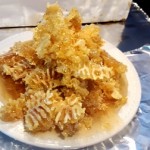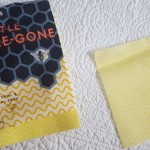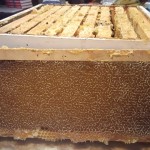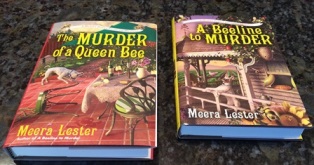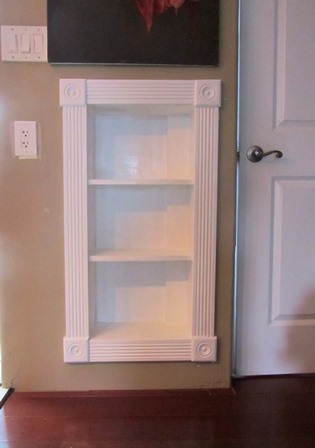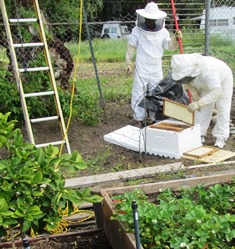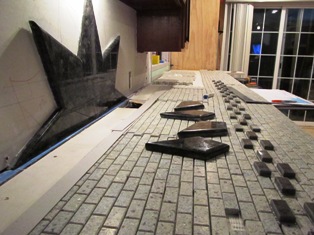Autumn Brings A Honey Harvest and Hive Treatment
Harvesting sweet-tasting, amber-colored honey from my hives has become an autumn ritual. This past Sunday, my beekeeper neighbor and I opened, inspected, and removed ten frames of honey from the one hive I have left.
The other hive succumbed to stress, a hive beetle infestation, and a steady march of ants. This despite me keeping my hives (and the apiary) pristine, dry, and facing the sun.
I found a beetle (no larvae) in the super we removed from the hive box when I scraped the frames clean of wax and bee glue. The tiny black insect had established itself in a crack under a plug of wax. Bees can’t sting through the beetle’s hard shell.
Without a powerful way of combating an infestation of beetles, the hive becomes stressed.Thank goodness, my neighbor had just the treatment to eliminate any other unseen beetles from my hive box.
Beetle Bee Gone sheets are an all natural and chemical-free method for treating hive beetle. Bees munch on the sheet that then becomes a fuzzy trap that ensnares the beetles. The beetles die.
In cool weather, which is what we have now, the hive beetle moves to the interior, above the brood, and/or under the hive cover. When the weather gets warmer, the pests move downward and so the placement of the sheets must be moved down.
My neighbor also inserted under the hive box lid a small plastic trough (as long as a pencil) with holes. He poured vegetable oil into the trough until it was half full. This, too, is a natural treatment against the hive beetle. The pests drown.
I’m optimistic that these treatments (along with others I’m using for mites) will keep the hive protected over winter so that in spring, I’ll get a new swarm to grow my diminished colony.
With the bees tended to, I turned my attention to the honey harvest. In all, the single super of ten frames produced roughly three gallons of honey once I’d prepped the frames and put them in the extractor. That’s more than enough honey to get my family through the winter and to present as gifts to friends along with jars of fruit jams and homemade sweets come Christmas.
_________________________________________________________________
If you enjoy reading about backyard beekeeping, caring for chickens, or growing organic vegetables, check out my Henny Penny Farmette series of books. All are available through traditional and online bookstores. To see more, click on the link.
The Murder of a Queen Bee–Reviews
I love it when the reviews start rolling in for one of my novels . . . in this case, THE MURDER OF A QUEEN BEE. Here’s a highlight of the Booklist review to be published in that magazine’s September 1, 2016 issue:
“Framed with details of beekeeping, herb growing, and living and working on a small farm in California, this charming cozy also includes well-drawn, engaging
characters and a promising new romance for Abby.”–Sue O’Brien
For more than a century, Booklist magazine has been and continues to be the go-to resource for American librarians (see, http://www.ala.org/offices/publishing/booklist/).
As libraries develop and evolve their collections of all types of library materials for virtually every genre and age group, they depend on reviews that Booklist provides. As an author, I appreciate having positive reviews from respected publications such as Booklist and Kirkus as well as other media in their respective platforms. As a cozy author, I also appreciate the exposure my novels get on blogging sites and other social media platforms.
* * *
Publisher’s Weekly, a major industry magazine that reviews books had this to say in its August 29, 2016 issue regarding THE MURDER OF A QUEEN BEE by Meera Lester (Kensington HC/October 2016/978-1-61773-913-2)
“Lester ticks all the boxes…This one is for lovers of cozy mysteries that are heavy on the cozy.” – Publishers Weekly
I’m also thrilled that Kirkus Review (see, https://www.kirkusreviews.com/), a valuable industry-firsts reviewing resource since 1933, has offered a review of my forthcoming novel, THE MURDER OF A QUEEN BEE that includes an excellent plot summary and this take-away quote about my protagonist ex-cop Abigail Mackenzie:
“Abby naturally finds it hard to concentrate on murder while she’s trying to decide what to do about Clay and her newfound attraction to Jack. The second from Lester (A Beeline To Murder, 2016) is long on romance, sweet tips, and honey recipes. . . . [and] mystery, too.”
The Murder of a Queen Bee, byLester, Meera
312 p. Kensington, hardcover, $25. (9781617739132)
E-book, $11.99. (9781617739149).
These novels are available through online retailers such as Amazon, Barnes & Noble, Kobo Books, and Walmart as well as from traditional bookstores everywhere.
See, http://tinyurl.com/hxy3s8q
Now available in mass market paperback, this debut novel launched the Henny Penny Farmette series of mysteries and sold out its first press run.
See, http://tinyurl.com/h4kou4g
The second cozy mystery in the Henny Penny Farmette series, available Sept. 27, 2016, is now available on Net Galley (netgalley.com) for professionals and readers who write reviews.
Creating Functional Space in Our Small Farmhouse Kitchen
“There’s never enough storage space!” It’s become a lament I want to banish from my frequent utterances.

Our farmhouse kitchen counter and cabinets during early renovation. Carlos cut the sunburst pattern from blue-black granite
At roughly 1,000 square feet, our house isn’t terribly small by the 1970’s standard when the average American home was 1,400 square feet. And by the 195o’s standard of 983 square feet, my house is positively roomy. However, today, the average American house footprint stands at 2,598 square feet. That said, there is a tiny house movement on and that’s a good thing for the environment.
Having lived in larger houses, I can honestly say I love this smaller home. The costs for energy, upkeep, homeowner’s insurance, and property taxes are considerably less. The need for interior furnishings shrinks, too.
The downside is there is less space for storage. We have had to maximize our options. I keep bees and beekeeper supplies like honey jars and lids as well as my cases of jam jars and lids and the final, finished products have to be stored somewhere. And then there are my cookbooks (I’ve cut the collection from over a hundred to a quarter of that).
My designer/architect husband Carlos Carvajal came to my rescue by carving out some space for bookcase in the wall between the kitchen and the bar area.
He also took space from the kitchen to create a laundry area with washer and dryer and hid them behind bi-fold doors.
The bar area has a bank of lower cabinets that can hold glassware, appetizer dishes, and serving platters. He re-created a new cabinet unit from a bank of old upper kitchen cabinets, mounting them on the wall above the granite counter-top with an inset sink.
A narrow moveable butcher block cart on wheels with a couple of shelves could give me a little extra storage, if we could find one that would fit in the limited space near the oven.
I think we’ve maximized our storage options in the kitchen and created a highly functional space so maybe I can now abandon that lament.
How My Real Life Informs My Art
Every story needs a setting, a world in which something happens. For my cozy mysteries, I didn’t set out to create a new world for my coterie of characters, I just appropriated details of the life I am living as a farmette dweller.
Daily chores on our Henny Penny Farmette provide plenty of fodder for my fictional stories. Our daily activities include chicken care, garden and orchard work, beekeeping, cooking and preservation of vegetables and fruits, renovating the antiquated farm house, fixing sheds, and building fences and retaining walls.
Stories need a sense of verisimilitude for readers to suspend disbelief and join the fictional journey. Drawing upon my real-life experiences, I can easily integrate my adventures in my books. And not only my activities, but also experiences of my architect husband who is ever-occupied with making our old house more liveable.
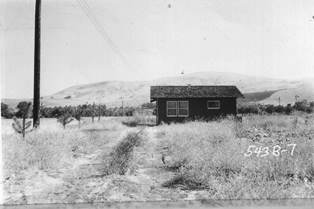
In this 1953 photo, our little house sat in a great, big field with not much around it; the dwelling faced Mount Diablo (still does) and the Delta and great central valley lie to the northeast
The tax assessor told me that our dwelling might have been a mining shack in the late 1940s (we live near Mt. Diablo and Lime Ridge where mining and rock quarrying were once important industries). We’ve also been told that our little house might have later served as a farm home (we live less than two miles from designated agricultural farmland). The structure desperately needed updating when we found it almost five years ago. But as settings go, the house and farmette work great.
We have since used recycled and reclaimed materials, sale items at big box DIY stores, and gifts (like lumber, stone, and windows/doors) from friends who do demolition on estates. We’ve visited companies that sell granite and asked for permission to take broken stone from their dumpsters. Thus, we’ve created a lovely bathroom floor with found materials that we’ve cut and sanded.

Light from a crystal chandelier dances off the new granite counter, but the floors were not yet installed when this photo was taken
Of course, the exact details of our daily activities may not make their way into my stories, but versions of them sometimes do. At the very least, such activities inform my storytelling. I daresay the chickens and bees serve important roles in my mysteries. And each new day brings new adventures, from foxes showing up to skunks and raccoons raiding our fruit and nut trees.
Lately, a new chicken showed up on our property (a heritage chicken that had the ability to fly over my neighbor’s fence). She’s been staying here ever since. Wild turkeys often take a path through the property and once or twice a gorgeous stallion named Romeo and its owner ride by and say hello. Such events can add textural details to the setting of a story.
Travel Is a Gift that Keeps on Giving
Farmette life keeps me close to home these days, but lately I’ve been thinking about some of the places I’ve been in the world and it occurred to me that travel has inspired and, in many ways, transformed me. It also has broadened my horizons, shaped my worldview, and contributed immeasurably to my sense of well-being.

Ephesus, a few miles from Kusadasi, on Turkey’s turquoise coast, has spectacular ruins like this Greco-Roman library
The nice thing about travel is that it also can nurture your spirit and inform your writing. Since I’ve traveled a bit–something like 29 countries–mostly for pleasure and always on my own dime, I’ve met some wonderful people, tasted some great cuisine and wines, saw fantastic architecture, and learned colorful, cultural tidbits along the way.
Today as I was working on my Henny Penny Farmette mystery series, I thought about how I’d tasted the organic wines and fresh herbs of Greece, the chocolates of Belgium, honey in England, jams and tea in Ireland and Wales, spices of all kinds in India, wine and cheese in France, shortbread and butter cookies in Scotland, apple strudel all over Switzerland and Austria, and fine olive oil in Italy.
Travel for me is about food, people, and experiences during the journey. So often, in our world of bucket lists and destination travel, we miss the point of the journey. For me, it’s the life on the road that happens on the way to a destination that informs my writing and my worldview.
My first cozy mystery BEELINE TO MURDER draws upon farmette life and deals with beekeeping and honey and pastries, but also ties into the Caribbean. That book will be released October 2015.
My second book in the cozy mystery series focuses on herbs and has a tie-in to Haiti. That book comes out October 2016.
The third book involves the world of artisan chocolate. That book will be released October 2017. To write these books, I draw deeply from the well of experience and tap into my senses. Although the main focus of my novels is about solving a murder mystery, the stories always involve food and drink–a universal experience involving the senses.
For millennia, people have lived close to the earth, growing their own food, pressing their olives into oil, harvesting honey from their hives, and making their own wine. It’s how many of us choose to live today. That sense of connectedness–resonating across cultures, through centuries–informs my writing most of all.
 Facebook
Facebook Goodreads
Goodreads LinkedIn
LinkedIn Meera Lester
Meera Lester Twitter
Twitter





